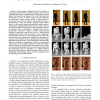135 search results - page 9 / 27 » Representation and Recognition of Complex Human Motion |
ROMAN
2007
IEEE
14 years 1 months ago
2007
IEEE
Abstract— This paper describes a novel algorithm for autonomous and incremental learning of motion pattern primitives by observation of human motion. Human motion patterns are ed...
CVPR
2010
IEEE
14 years 3 months ago
2010
IEEE
A central problem in the analysis of motion capture (Mo-
Cap) data is how to decompose motion sequences into primitives.
Ideally, a description in terms of primitives should
fac...
PAMI
2011
12 years 10 months ago
2011
—We present a discriminative part-based approach for human action recognition from video sequences using motion features. Our model is based on the recently proposed hidden condi...
IROS
2009
IEEE
14 years 2 months ago
2009
IEEE
— Programming a humanoid robot to perform an action that takes the robot’s complex dynamics into account is a challenging problem. Traditional approaches typically require high...
ECCV
2010
Springer
13 years 11 months ago
2010
Springer
Abstract. Much recent research in human activity recognition has focused on the problem of recognizing simple repetitive (walking, running, waving) and punctual actions (sitting up...

